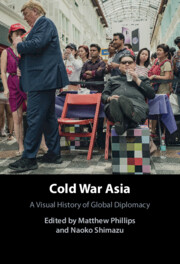Refine search
Actions for selected content:
77 results
10 - Singapore’s Evolving AI Governance Framework
- from Part II - Evolving Regulatory and Governance Frameworks
-
-
- Book:
- The Cambridge Handbook of Generative AI and the Law
- Published online:
- 08 August 2025
- Print publication:
- 07 August 2025, pp 151-168
-
- Chapter
- Export citation
7 - National Narcotics Agencies in Southeast Asia
- from Part III - Actors and Agencies
-
-
- Book:
- Capital Drug Laws in Asia
- Published online:
- 07 August 2025
- Print publication:
- 24 July 2025, pp 167-199
-
- Chapter
- Export citation
Alcohol consumption among university students in ASEAN countries: A systematic review and meta-analysis
-
- Journal:
- Cambridge Prisms: Global Mental Health / Volume 12 / 2025
- Published online by Cambridge University Press:
- 20 June 2025, e69
-
- Article
-
- You have access
- Open access
- HTML
- Export citation
6 - Building Institutional Peace in the Asia Pacific in the 21st Century
-
- Book:
- The Upside of US-Chinese Strategic Competition
- Published online:
- 25 June 2025
- Print publication:
- 05 June 2025, pp 148-169
-
- Chapter
- Export citation
9 - A Diplomatic Image and Its Afterlife
-
-
- Book:
- Cold War Asia
- Published online:
- 30 January 2025
- Print publication:
- 06 February 2025, pp 190-209
-
- Chapter
- Export citation

Cold War Asia
- A Visual History of Global Diplomacy
-
- Published online:
- 30 January 2025
- Print publication:
- 06 February 2025
15 - The Third Indochina War
- from Part II - The Postwar Era
-
-
- Book:
- The Cambridge History of the Vietnam War
- Published online:
- 02 January 2025
- Print publication:
- 28 November 2024, pp 333-352
-
- Chapter
- Export citation
7 - Hydrogen Regulation in Southeast Asia
- from Part I - Current Hydrogen Regulation on the Continents
-
-
- Book:
- The Cambridge Handbook of Hydrogen and the Law
- Published online:
- 28 November 2024
- Print publication:
- 28 November 2024, pp 98-112
-
- Chapter
-
- You have access
- Open access
- HTML
- Export citation
3 - The Sino-Vietnamese War (February 1979)
-
- Book:
- The Third Indochina War
- Published online:
- 07 November 2024
- Print publication:
- 21 November 2024, pp 69-89
-
- Chapter
- Export citation
4 - Regional Responses to the Vietnamese Invasion
-
- Book:
- The Third Indochina War
- Published online:
- 07 November 2024
- Print publication:
- 21 November 2024, pp 90-109
-
- Chapter
- Export citation
13 - Australia’s engagement with ASEAN
- from Part III - Regional issues
-
-
- Book:
- Australia in World Affairs 2016–2020
- Published online:
- 25 October 2024
- Print publication:
- 13 June 2024, pp 174-187
-
- Chapter
- Export citation
3 - Understanding and Resolving Norm Conflict
- from Part I - Norm Strength, Collisions, and Conflicts
-
-
- Book:
- Contesting the World
- Published online:
- 01 November 2024
- Print publication:
- 06 June 2024, pp 43-63
-
- Chapter
- Export citation
Rewriting the law of international organizations: Whither the Asia Pacific?
-
- Journal:
- Leiden Journal of International Law / Volume 37 / Issue 3 / September 2024
- Published online by Cambridge University Press:
- 09 May 2024, pp. 694-715
-
- Article
-
- You have access
- Open access
- HTML
- Export citation
10 - Australia and Southeast Asia
-
-
- Book:
- Australia in World Affairs 1991–1995
- Published online:
- 04 May 2024, pp 108-122
-
- Chapter
- Export citation
10 - Progress and Limits in Regional Cooperation: Australia and Southeast Asia
-
-
- Book:
- Australia in World Affairs 2006–2010
- Published online:
- 04 May 2024, pp 143-159
-
- Chapter
- Export citation
Introduction
-
- Book:
- Energy and the Environment
- Published online:
- 30 April 2024
- Print publication:
- 02 May 2024, pp 1-11
-
- Chapter
-
- You have access
- HTML
- Export citation
Smart Cities and International Trade Law
-
- Journal:
- World Trade Review / Volume 23 / Issue 3 / July 2024
- Published online by Cambridge University Press:
- 08 April 2024, pp. 363-384
- Print publication:
- July 2024
-
- Article
-
- You have access
- Open access
- HTML
- Export citation
6 - Regionalism the ‘Pacific Way’
-
- Book:
- Regional Politics in Oceania
- Published online:
- 15 February 2024
- Print publication:
- 22 February 2024, pp 142-171
-
- Chapter
- Export citation
Commentary
-
- Book:
- Recentering Pacific Asia
- Published online:
- 03 August 2023
- Print publication:
- 17 August 2023, pp 148-152
-
- Chapter
- Export citation
Chapter 3 - Codifying Patterns of Interaction
-
- Book:
- Conversation in World Englishes
- Published online:
- 30 March 2023
- Print publication:
- 06 April 2023, pp 18-55
-
- Chapter
- Export citation
